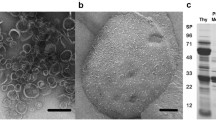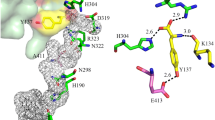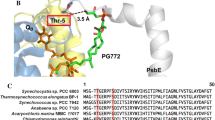Abstract
NADPH:protochlorophyllide oxidoreductase (POR) catalyzes the light-dependent reduction of protochlorophyllide (pchlide) to chlorophyllide (chlide) in the biosynthesis of chlorophyll. POR is a peripheral membrane protein that accumulates to high levels in the prolamellar bodies of vascular plant etioplasts and is present at low levels in the thylakoid membranes of developing and mature plastids. Clustered charged-to-alanine scanning mutagenesis of the pea (Pisum sativum L.) POR was carried out and the resulting mutant enzymes analyzed for their ability to catalyze pchlide photoconversion in vivo and to associate properly with thylakoid membrane preparations in vitro. Of 37 mutant enzymes examined, 5 retained wild-type levels of activity, 14 were catalytically inactive, and the remaining 18 exhibited altered levels of function. Several of the mutant enzymes showed temperature- dependent enzymatic activity, being inactive at 32 °C, but partially active at 24 °C. Mutations in predicted α- helical regions of the protein showed the least effect on enzyme activity, whereas mutations in predicted β-sheet regions of the protein showed a consistent adverse affect on enzyme function. In the absence of added NADPH, neither wild-type POR nor any of the mutant PORs resisted proteolysis by thermolysin following assembly onto the thylakoid membranes. In contrast, when NADPH was present in the assay mixture, 13 of the 37 mutant PORs examined were found to be resistant to thermolysin upon treatment, suggesting that the mutations did not affect their ability to be properly attached to the thylakoid membrane. In general, the replacement of charged amino acids by alanine in the most N- and C-terminal regions of the mature protein did not significantly affect POR assembly, whereas mutations within the central core of the protein (between residues 86 and 342) were incapable of proper attachment to the thylakoid. Failure to properly associate with the thylakoid membrane in a protease resistant manner was only weakly correlated to loss of catalytic function. These studies are a first step towards defining structural determinants crucial to POR function and intraorganellar localization.
Similar content being viewed by others
References
Albalat R, Valls M, Fibla J, Atrian S, Gonzàlez-Duarte R: Involvement of the C-terminal tail in the activity of Drosophila alcohol dehydrogenase. Evaluation of truncated proteins constructed by site-directed mutagenesis. Eur J Biochem 233: 508–505 (1995).
Baker ME: Protochlorophyllide reductase is homologous to human carbonyl reductase and pig 20β-hydroxysteriod dehydrogenase. Biochem J 300: 605–607 (1994).
Begley TP: Photoenzymes: a novel class of biological catalysts. Acc Chem Res 27: 394–401 (1994).
Begley TP, Young H: Protochlorophyllide reductase. I. Determination of the regiochemistry and the stereochemistry of the reduction of protochlorophyllide to chlorophyllide. J Am Chem Soc 111: 3095–3096 (1989).
Birve SJ, Selstam E, Johansson B-Å: Secondary structure of NADPH:protochlorophyllide oxidoreductase examined by circular dichroism and prediction methods. Biochem J 317: 549–555 (1996).
Cheneveret SW, Fossett NG, Chang SH, Tsigelny I, Baker ME, LeeWR: Amino acids important in enzyme activity and dimer stability for Drosophila alcohol dehydrogenase. Biochem J 308: 419–423 (1995).
Cline K: Import of proteins into chloroplasts. Membrane integration of a thylakoid precursor protein reconstituted in chloroplast lysates. J Biol Chem 261: 14804–14810 (1986).
Cline K, Henry R: Import and routing of nucleus-encoded chloroplast proteins. Annu Rev Cell Dev Biol 12: 1–26 (1996).
Cunningham BC, Wells JA: High-resolution epitope mapping of hGH-receptor interactions by alanine-scanning mutagenesis. Science 245: 1081–1085 (1989).
Dahlin C, Timko MP: Integration of nuclear-encoded proteins into carotenoid-deficient pea thylakoids. Physiol Plant 91: 212–218 (1994).
Dahlin C, Sundqvist C, Tiniko MP: The in vitro assembly of NADPH-protochlorophyllide oxidoreductase in pea chloroplasts. Plant Mol Biol 29: 317–330 (1995).
Fujita Y: Protochlorophyllide reduction: a key step in the greening of plants. Plant Cell Physiol 37: 411–421 (1996).
Ghosh D, Weeks CM, Grochulski P, Duax WL, Erman M, Rimsay RM, Orr JC: Three-dimensional structure of holo 3α, 20β-hydroxysteriod dehydrogenase: a member of a shortchain dehydrogenase family. Proc Natl Acad Sci USA 88: 10064–10068 (1991).
Ghosh D, Wawrzak Z, Weeks CM, Duax WL, Erman M: The refined three-dimensional structure of 3α, 20β-hydroxysteriod dehydrogenase and possible roles of the residues conserved in the short-chain dehydrogenases. Structure 2: 629–640 (1994).
Griffiths WT: Reconstitution of chlorophyllide formation by isolated etioplast membranes. Biochem J 174: 681–692 (1978).
Griffiths WT: Substrate-specificity studies on protochlorophyllide reductase in barley (Hordeum vulgare) etioplast membranes. Biochem J 186: 267–278 (1980).
Griffiths WT: Protochlorophyllide photoreduction. In: Scheer H (ed) The Chlorophylls, pp. 433–449. CRC Press, Boca Raton, FL (1991).
Griffiths WT, McHugh T, Blankenship RE: The light intensity dependence of protochlorophyllide photoconversion and its significance to the catalytic mechanism of protochlorophyllide reductase. FEBS Lett 398: 236–238 (1996).
He QF, Brune D, Nieman R, Vermaas W: Chlorophyll a synthesis upon interruption and deletion of por coding the light-dependent NADPH:protochlorophyllide oxidoreductase in the photosystem-I-less/chlL- strain of Synechocustis sp. PCC 6803. Eur J Biochem 253: 161–172 (1998).
Helfrich M, Schoch S, Schafer W, Ryberg M, Rudiger W: Absolute configuration of protochlorophyllide alpha and substrate specificity of NADPH-protochlorophyllide oxidoreductase. J Am Chem Soc 118: 2606–2611 (1996).
Jörnval H, Persson B, Krook M, Atrian S, Gonzàlez-Duarte R, Jeffery J, Ghosh D: Short-chain dehydrogenases/reductases (SDR). Biochemistry 34: 6003–6013 (1995).
Kasturi S, Kihara A, FitzGerald D, Pastan I: Alanine scanning mutagenesis identifies surface amino acids on Domain II of Pseudomonas exotoxin required for cytotoxicity, proper folding, and secretion into periplasm. J Biol Chem 267: 23427–23433 (1992).
Kay SA, Griffiths WT: Light-induced breakdown of NADPHprotochlorophyllide oxidoreductase in vitro. Plant Physiol 72: 229–236 (1983).
Knaust R, Seyfried B, Schmidt L, Schulz R, Senger H: Phototransformation of monovinyl and divinyl protochlorophyllide by NADPH: protochlorophyllide oxidoreductase of barley expressed in Escherichia coli. J Photochem Photobiol B-Biology 20: 161–166 (1993).
Krook M, Ghosh D, Strömberg R, Carlquist M, Jörnvall H: Carboxyethyllysine in a protein: Native carbonyl reductase/NADPC-dependent prostaglandin dehydrogenase. Proc Natl Acad Sci USA 90: 502–606 (1993).
Labesse G, Vidat-Cors A, Chomilier J, Gaudry M, Momon J-P: Structural comparisons lead to the definition of a new superfamily of NAD(P)(H)-accepting oxidoreductases: the single-domain reductases/epimerases/dehydrogenases (the 'RED' family). Biochem J 304: 95–99 (1994).
Laemmli LJK: Cleavage of structural proteins during the assembly of the head of bacteriophage T4. Nature 227: 680–685 (1970).
Li J, Timko MP: The pc-1 phenotype of Chlamydomonas reinhardtii results from a deletion mutation in the nuclear gene for NADPH: protochlorophyllide oxidoreductase. Plant Mol Biol 30: 15–37 (1996).
Li N, Zhao J, Warren PV, Warden JT, Bryan DA, Golbeck JH: PsaD is required for the stable binding of PsaC to the photosystem I core protein of Synechococcus sp. PCC 6301. Biochemistry 30: 7863–7872 (1991).
Lichtenthaler HK, Weilburn AR: Determination of total carotenoids and chlorophylls a and b of leaf extracts in different solvents. Biochem Soc Trans 603: 591–592 (1983).
Martin GEM, Timko MP and Wilks HM: Purification and kinetic analysis of pea NADPH-protochlorophyllide oxidoreductase expressed as a fusion with maltose-binding protein in Escherichia coli. Biochem J 325: 139–145 (1997).
Ogawa T, Inoue Y, Kitajima M, Shibata K: Action spectra for biosynthesis of chlorophylls a and b and β-carotene. Photochem Photobiol 18: 229–235 (1973).
Oliver RP, Griffiths WT: Covalent labelling of the NADPH:protochlorophyllide oxidoreductase from etioplast membranes with (3H)N-phenylmaleimide. Biochem J 195: 93–101 (1981).
Persson B, Krook M, Jörnvall H: Characteristics of short-chain alcohol dehydrogenases and related enzymes. Eur J Biochem 200: 537–543 (1991).
Reinbothe S, Reinbothe C: The regulation of enzymes involved in chlorophyll biosynthesis. Eur J Biochem 237: 323–343 (1996).
Reinbothe C, Apel K, Reinbothe S: A light-induced protease from barley plastids degrades NADPH:protochlorophyllide oxidoreductase completed with chlorophyllide. Mol Cell Biol 15: 6206–6212 (1995).
Reinbothe S, Reinbothe C, Lebedev N, Apel K: PORA and PORB, two light-dependent protochlorophyllide-reducing enzymes of angiosperm chlorophyll biosynthesis. Plant Cell 8: 763–769 (1996).
Reinbothe S, Reinbothe C, Runge S, Apel K: Enzymatic product formation impairs both the chloroplast receptorbinding function as well as translocation competence of the NADPH:protochlorophyllide oxidoreductase, a nuclearencoded plast precursor protein. J Cell Biol 129: 299–308 (1995).
Reinbothe S, Runge S, Reinbothe C, van Cleve B, Apel K: Substrate-dependent transport of the NADPH:protochlorophyllide oxidoreductase into isolated plastids. Plant Cell 7: 161–172 (1995).
Robinson C, Klösgen RB: Targeting of proteins into and across the thylakoid membrane: a multitude of mechanisms. Plant Mol Biol 26: 15–24 (1994).
Sali A, Blundell TL: Comparative protein modeling by satisfaction of spatial restraints. J Mol Biol 234: 779–815 (1993).
Schulz R, Steinmuller K, Klaas M, Forreiter C, Rasmussen S, Hiller C, Apel K: Nucleotide sequence of a cDNA coding for the NADPH-protochlorophyllide oxidoreductase (PCR) of barley (Hordeum vulgare L.) and its expression in Escherichia coli. Mol Gen Genet 217: 355–361 (1989).
Spano AJ, He Z, Michel H, Hunt DF, Timko MP: Molecular cloning, nuclear gene structure, and developmental expression of NADPH: protochlorophyllide oxidoreductase in pea (Pisum sativum L.). Plant Mol Biol 18: 967–972 (1992).
Sundqvist C, Dahlin C: With chlorophyll pigments from prolamellar bodies to light-harvesting complexes. Physiol Plant 100: 748–759 (1997).
Tanaka N, Nonaka T, Nakanishi M, Deyashiki Y, Hara A, Mitsui Y: Crystal structure of the ternary complex of mouse lung carbonyl reductase at 1.8Å resolution: the structural origin of coenzyme specificity in the short-chain dehydrogenase/ reductase family. Structure 4: 33–45 (1996).
Tsigelny I, Baker ME: Structures stabilizing the dimer interface on human 11β-hydroxysteriod dehydrogenase types 1 and 2 and human 15-hydroxyprostaglandin dehydrogenase and their homologues. Biochem Biophys Res Comm 217: 859–868 (1995).
Valera V, Fung M, Wessler AN, Richards: Synthesis of 4Rand 4S-tritium labeled NADPH for determination of the coenzyme stereospecificity of NADPH:protochlorophyllide oxidoreductase. Biochem Biophys Res Comm 148: 515–520 (1987).
Wermuth B: Purification and properties of an NADPHdependent carbonyl reductase from human brain. Relationship to prostaglandin 9-ketoreductase and xenobiotic ketone reductase. J Biol Chem 256: 1206–1213 (1981).
Wertman KF, Drubin DG, Botstein D: Systematic mutational analysis of the yeast ACT1 gene. Genetics 132: 337–350 (1992).
Whyte BJ, Griffiths WT: 8-Vinyl reduction and chlorophyll a biosynthesis in higher plants. Biochem J 291: 939–944 (1993).
Wilks HM, Timko MP: A light-dependent complementation system for analysis of NADPH:protochlorophyllide oxidoreductase. Identification and mutagenesis of two conserved residues that are essential for enzyme activity. Proc Natl Acad Sci USA 92: 724–728 (1995).
Author information
Authors and Affiliations
Rights and permissions
About this article
Cite this article
Dahlin, C., Aronsson, H., Wilks, H.M. et al. The role of protein surface charge in catalytic activity and chloroplast membrane association of the pea NADPH: protochlorophyllide oxidoreductase (POR) as revealed by alanine scanning mutagenesis. Plant Mol Biol 39, 309–323 (1999). https://doi.org/10.1023/A:1006135100760
Issue Date:
DOI: https://doi.org/10.1023/A:1006135100760




